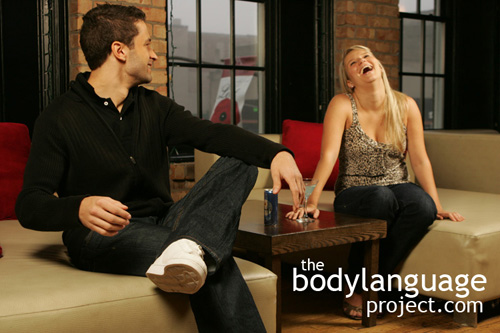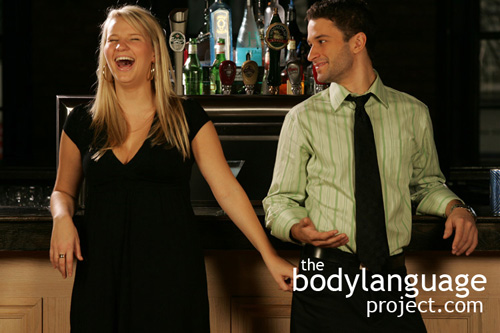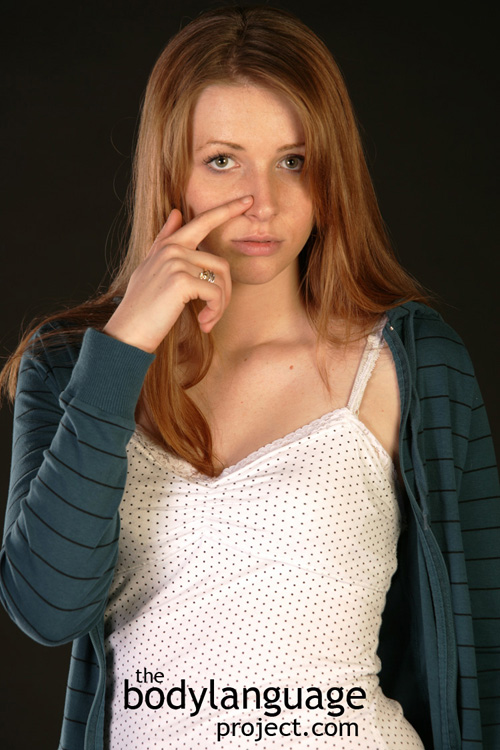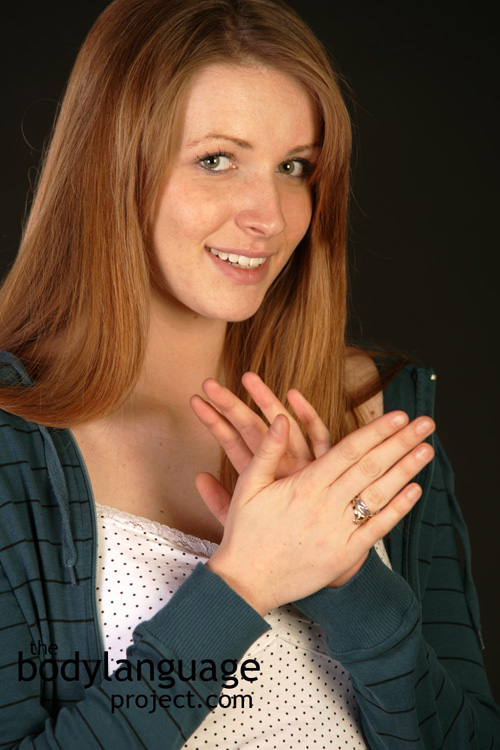Body Language of the Prance Gait
Synonym(s): Prancing, Walking On Air, Walking With A Bounce In The Step, Bound In The Gait.
Description: A playful gait which is peppered with unnecessary leaps and bounces.
In One Sentence: The prance gait signals a high degree of femininity due to happiness and health.
How To Use it: Children can use the prance for best effect to show their good spirits. Women are also permitted by our culture to prance and when men prance, they can use it for comedic effect.
A more muted prance can work in both woman and men, however, and is useful in showing others your good health and good spirits. Rather than an exaggerated prance, a mute prance is simply a youthful gait which produces a slight leap in the steps as if floating on air.
Use the prance in any context in which health and virility will be seen as a positive trait. In dating, a bound in the step will show your partner that you have good character and good genetics. This is especially useful to women whom can show off their youth, and hence fertility, with a bound in their step.
Context: a) General b) Dating.
Verbal Translation: “I’m so happy and healthy and want everyone to notice. When I walk, I like to expend more energy than is practical or necessary.”
Variant: A woman may use the parade style of walking which exaggerates the motion of the hips, forcing them to cant from side-to-side. A playful prance intermixed with a parade style of walking shows a person in good spirit who has good childbearing hips. See Gait or Walking Styles.
Cue In Action: a) The girls and boys happily pranced around the playground while the parents ambled after them – barely keeping up. a) He just won the lottery and you could tell. His head was held high, it was as if he was walking on the clouds with a confident stride, buoyant, and youthful. b) Her youth was apparent. When she walked, she had a noticeable bound in her step indicating her health, vigor and good spirit. She advertised her sexuality with her prance.
Meaning and/or Motivation: The prance indicates good spirit and confidence usually associated with youth and thus health.
A bound in the gait indicates a persons ability and desire to fight the effects of gravity. When people win, they celebrate by thrusting their arms up in the air to draw attention to themselves. The same is true about our gait. It is often found in adults who feel that they have control over their lives and those who have enjoyed successes.
Conversely, those who lack confidence or who are depressed will hang their shoulders and saunter about instead. The prance is a type of gait that advertises to the world that a person is happy and content is worthy of our association.
The prancing gait also indicates the virility of a person when carried by those of sexual maturity. Prancing is a sign that they make a good sexual partner partially due to their optimism and good spirit, but also their youthfulness and health. This makes the prance a strong indicator of physical and mental fitness.
Cue Cluster: Watch for head held high with chin up, smiling face and a smooth stride with straight back.
Body Language Category: Amplifier, Confident body language, Childlike playfulness, Enthusiasm (nonverbal), Excited body language, Gravity defying body language, Happiness, High confidence body language, Up nonverbals.
Resources:
Angela Book, Kimberly Costello and Joseph A. Camilleri Psychopathy and Victim Selection: The Use of Gait as a Cue to Vulnerability. Journal of Interpersonal Violence. 2013. 28(11): 2368-2383. DOI: 10.1177/0886260512475315jiv.sagepub.com
http://bodylanguageproject.com/articles/dont-walk-like-youre-watched-avoid-victimization-nonverbal-behavior/
Atkinson AP, Dittrich WH, Gemmell AJ, Young AW (2004) Emotion perception from dynamic and static body expressions in point-light and full-light displays. Perception 33: 717–746. doi: 10.1068/p5096.
Boone RT, Cunningham JG (1998) Children’s decoding of emotion in expressive body movement: the development of cue attunement. Dev Psychol 34: 1007–1016. doi: 10.1037//0012-1649.34.5.1007.
Brownlow S, Dixon AR, Egbert CA, Radcliffe RD (1997) Perception of movement and dancer characteristics from point-light displays of dance. Psychol Rec 47: 411–421.
Camurri A, Lagerlo¨f I, Volpe G (2003) Recognizing emotion from dance movement: Comparison of spectator recognition and automated techniques. Int J Hum Comput Stud 59: 213–225. doi: 10.1016/S1071-5819(03)00050-8.
Crane, Elizabeth ; Gross, M. Effort-Shape Characteristics of Emotion-Related Body Movement. Journal of Nonverbal Behavior. 2013. 37(2): 91-105.
de Meijer M (1989) The contribution of general features of body movement to the attribution of emotions. J Nonverbal Behav 13: 247–268. doi: 10.1007/BF00990296.
Dittrich WH, Troscianko T, Lea SEG, Morgan D (1996) Perception of emotion from dynamic point-light displays represented in dance. Perception 25: 727–738. doi: 10.1068/p250727.
Fink, Bernhard; Nadine Hugill and Benjamin P. Lange. Women’s Body Movements Are a Potential Cue to Ovulation. Personality and Individual Differences. 2012. 53: 759-763.
http://bodylanguageproject.com/articles/women-use-sexier-body-language-indicate-ovulation-fertility-women-dance-walk-sexier/
Godøy R (2010) Gestural affordances of musical sound. In: Godøy R, Leman M, editors. Musical gestures: Sound, movement, and meaning. New York, NY: Routledge. 103–125.
Gunns, Rebekah E; Lucy Johnston; and Stephen M. Hudson. Victim Selection And Kinematics: A Point-Light Investigation Of Vulnerability To Attack. Journal of Nonverbal Behavior. 2002. 26(3): 129-158.
http://bodylanguageproject.com/articles/how-to-avoid-an-attack-just-by-changing-how-you-walk-study/
Guéguen N. Gait and menstrual cycle: ovulating women use sexier gaits and walk slowly ahead of men. Gait Posture. 2012; 35(4): 621-4.
http://bodylanguageproject.com/articles/gait-as-bait-women-walk-sexy-during-high-sexual-receptivity/
Gross, M Melissa ; Crane, Elizabeth A ; Fredrickson, Barbara L. Effort-Shape and kinematic assessment of bodily expression of emotion during gait. Human movement science. 2012. 31(1): 202-21.
Hasegawa, T. and K. Sakaguchi. 2006. Person perception through gait information and target choice for sexual advances: comparison of likely targets in experiments and real life. Journal of Nonverbal Behavior 30(2): 63-85.
Johnson, Kerri L.; Gill, Simone; Reichman, Victoria and Tassinary, Louis G. Swagger, Sway, and Sexuality: Judging Sexual Orientation from Body Motion and Morphology. Journal of Personality and Social Psychology. 2007. 93(3): 321-334. doi: 10.1037/0022-3514.93.3.321
http://bodylanguageproject.com/articles/heterosexual-vs-homosexual-swagger-can-you-spot-the-difference/
Janssen, Daniel ; Schöllhorn, Wolfgang ; Lubienetzki, Jessica ; Fölling, Karina ; Kokenge, Henrike ; Davids, Keith. Recognition of Emotions in Gait Patterns by Means of Artificial Neural Nets. Journal of Nonverbal Behavior. 2008. 32(2): 79-92.
Lagerlo¨f I, Djerf M (2000) Communicating emotions: Expressiveness in modern dance. Int J Psychol 35: 225–225.
Montepare, J. M., Goldstien, S. B., & Clausen, A. (1987). The identification of emotions from gait information. Journal of Nonverbal Behavior, 11, 33–42.
Miller, G., Tybur, J. M., & Jordan, B. D. Ovulatory cycle effects on tip earning by lap dancers: Economic evidence for human estrus. Evolution and Human Behavior. 2007. 28: 375-381. http://dx.doi.org/10.1016/j.evolhumbehav.2007.06.002.
Michalak, J., Rohde, K., Troje, N. F. How We Walk Affects What We Remember: Gait Modifications Through Biofeedback Change Negative Affective Memory Bias. Journal of Behavior Therapy and Experimental Psychiatry. 2015. 46:121-125.
http://bodylanguageproject.com/articles/walking-happy-leads-actual-happiness-game-emotions-body-language/
Moore, Monica. Courtship Signaling and Adolescents: Girls Just Wanna Have Fun. Journal of Sex Research. 1995. 32(4): 319-328.
http://bodylanguageproject.com/articles/girls-just-want-to-have-fun-the-origins-of-courtship-cues-in-girls-and-women/
Moore, M. M. and D. L. Butler. 1989. Predictive aspects of nonverbal courtship behavior in women. Semiotica 76(3/4): 205-215.
Moore, M. M. 2001. Flirting. In C. G. Waugh (Ed.) Let’s talk: A cognitive skills approach to interpersonal communication. Newark, Kendall-Hunt.
Moore, M. M. 1985. Nonverbal courtship patterns in women: context and consequences. Ethology and Sociobiology 64: 237-247.
Montepare, Joann ; Zebrowitz, Leslie. A cross-cultural comparison of impressions created by age-related variations in gait. Journal of Nonverbal Behavior. 1993. 17(1): 55-68.
Montepare, Joann ; Goldstein, Sabra ; Clausen, Annmarie. The identification of emotions from gait information. Journal of Nonverbal Behavior. 1987. 11(1): 33-42.
Montepare, J. M., & Zebrowitz-McArthur, L. (1988). Impressions of people created by age-related qualities of their gaits. Journal of Personality and Social Psychology, 55(4), 547–556. http://dx.doi.org/10.1037/ 0022-3514.55.4.547.
Negriff, Sonya ; Noll, Jennie G ; Shenk, Chad E ; Putnam, Frank W ; Trickett, Penelope K. Associations between nonverbal behaviors and subsequent sexual attitudes and behaviors of sexually abused and comparison girls. Child maltreatment. 2010. 15(2): 180-9.
Prasad, S., & Shiffrar, M. (2009). Viewpoint and the recognition of people from their movements. Journal of Experimental Psychology – Human Perception and Performance, 35(1), 39–49. http://dx.doi.org/10.1037/A0012728.
Roether, C. L., Omlor, L., Christensen, A., & Giese, M. A. (2009). Critical features for the perception of emotion from gait. Journal of Vision, 9(6), 1–32. http://dx.doi.org/10.1167/9.6.15.
Risner D (2009) What we know about boys who dance: The limitations of contemporary masculinity & dance education. In: Shay A, Fisher J, editors. When men dance: Choreographing masculinities across borders. New York, NY: Oxford University Press.
Sawada, M., Suda, K., & Ishii, M. (2003a). Expression of emotions in dance: Relation between arm movement characteristics and emotion. Perceptual and Motor Skills, 97, 697–708.
Sawada, M., Suda, K., & Ishii, M. (2003b). Relationship between leg movement quality and emotional expression in dance. Poster session presented at the annual meeting of the International Association for Dance Medicine & Science, London, England.
Sakaguchi, Kikue and Toshikazu Hasegawa. Person Perception Through Gait Information And Target Choice For Sexual Advances: Comparison Of Likely Targets In Experiments And Real Life. Journal of Nonverbal Behavior. 2006; 30:63-85. DOI 10.1007/s10919-006-0006-2
http://bodylanguageproject.com/articles/dont-walk-like-youre-asking-targets-sexual-approach-based-walking-style-personality-study/
Schneider, Sabrina ; Christensen, Andrea ; Hau[sz]inger, Florian B. ; Fallgatter, Andreas J. ; Giese, Martin A. ; Ehlis, Ann – Christine. Show me how you walk and I tell you how you feel — A functional near-infrared spectroscopy study on emotion perception based on human gait. Neuroimage. 2014. 85: 380(11).
Thoresen, John C.; Quoc C. Vuong and Anthony P. Atkinson. First Impressions: Gait Cues Drive Reliable Trait Judgements. Cognition. 2012. 261–271 Thoresen, John C.; Quoc C. Vuong and Anthony P. Atkinson. First Impressions: Gait Cues Drive Reliable Trait Judgements. Cognition. 2012. 261–271
http://bodylanguageproject.com/articles/walk-drives-first-impressions/
van der Zwan, Rick and Natasha Herbert. “I Like The Way You Move”: How Hormonal Changes Across The Menstrual Cycle Affect Female Perceptions of Gait. Research Notes. 2012; 5: 453.
http://bodylanguageproject.com/articles/women-at-peak-fertility-rate-other-female-walkers-less-favorably/
Van Meel J, Verburgh H, de Meijer M (1993) Children’s interpretation of dance
expressions. Empirical Studies of the Arts 11: 117–133. doi: 10.2190/V69NVB0T-
A9Q3-TJ04.
Van Dyck, Edith ; Vansteenkiste, Pieter ; Lenoir, Matthieu ; Lesaffre, Micheline ; Leman, Marc Canal-bruland, Rouwen. Recognizing Induced Emotions of Happiness and Sadness from Dance Movement. PLoS ONE. 2014 9(2): e89773.
Van Dyck E, Maes P-J, Hargreaves J, Lesaffre M, Leman M (2013). Expressing induced emotions through free dance movement. J Nonverbal Behav 37: 175–190. doi: 10.1007/s10919-013-0153-1.






